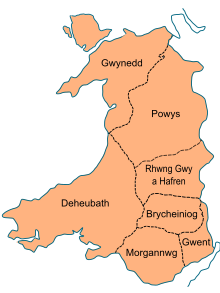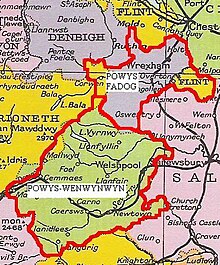Kingdom of Powys
The Powys Kingdom was a medieval kingdom and principality in Wales .
geography
Powys took the hill country of Mid Wales. It did not have its own access to the sea, but bordered Gwynedd in the north, Ceredigion in the west, Seisyllwg or Deheubarth in the southwest and Brycheiniog in the south . It consisted of the Cantrefi Maelor, Mechain, Cedewain and Cyfeiliog. In the north, Penllyn was controversial with Gwynedd, in the south Arwystli , Maelienydd, Gwrtheyrnion, Builth and Elfael were at times independent rulers.
history
From the end of the Roman era to the turn of the first millennium
Powys was one of the four kingdoms that arose in Wales after the end of Roman rule in the 5th century. It was ruled by the kings of the House of Gwerthrynion , who derived from the mythical Celtic ruler Vortigern . The seat of the kings was Pengwern , later also Mathrafal . After the Anglo-Saxons conquered the land in the 6th century, the Celtic Kingdom bordered the Kingdom of Mercia in the east . There were frequent bloody raids and wars of conquest between the Welsh and Anglo-Saxon kingdoms. In the 8th century, King Offa of Mercien built a border wall on the border with Powys, the Offa's Dyke , which for centuries served as a border line between Welsh and Anglo-Saxon areas. At the beginning of the 9th century Cenwulf of Mercia was able to conquer a large part of Powys, his successor Beornwulf was able to complete the conquest around 823. After the collapse of Mercia after the death of Beornwulf in 825, the Welsh king Cyngen ap Cadell was able to regain control of Powys. He was followed by his nephew Rhodri the Great , who was also King of Gwynedd. After Rhodri's death in 878, Powys was again an independent kingdom under his son Merfyn, but it was united with Gwynedd several times over the next few centuries, as under Hywel Dda or Gruffydd ap Llywelyn .
Beginning of the Norman Conquest
After the death of Gruffydd ap Llywelyn in 1063, the English King Edward the Confessor was able to appoint his ally Bleddyn ap Cynfyn as King of Powys. From 1071 the eastern border came under the pressure of the Norman conquest of Wales , as the English king William the Conqueror his confidant Roger de Montgomerie the Earl of Shrewsbury appointed. Bleddyn's son Cadwgan ap Bleddyn offered long-lasting resistance against the Norman conquest . Eventually, however, he had to make a peace with the Normans, through which he also became ruler of Ceredigon. Towards the end of his reign, Powys was shaken by brutal power struggles within his family, which Cadgwan also fell victim to. In these battles Cadwgan's brother Maredudd was finally able to prevail. Under him and his son Madog Powys was able to assert itself next to Gwynedd and at times became the leading Welsh principality.
Division into north and south powys
After the death of Madog ap Maredudd, his sons shared his kingdom with his nephew Owain Cyfeiliog , so that Powys finally split up into several principalities and no longer played a leading role in Welsh history. The main division took place in a southern principality, which was named from about 1200 after its prince Gwenwynwyn Powys Wenwynwyn , and a northern principality, which was named after its then prince Madog ap Gruffydd Powys Fadog to distinguish southern Powys . In contrast to Powys Fadog, from whom other lords split off, Powys Wenwynwyn remained undivided.
North Powys or Powys Fadog
When Powys was divided after the death of Madog ap Maredudd, his three sons received the areas north of the River Rhaeadr and the Tanat . The younger sons Owain Fychan and Owain Brogyntyn received their own dominions in Mechain, Edeirnion and Penllyn under the suzerainty of their brother Gruffydd Maelor , who remained lord of Maelor, Iâl, Cynllaith, Nanheudwy and parts of Mochnant. However, Gruffydd Maelor's heirs increasingly lost control of the subsidiary lines, which were partly also further divided. All the lords of Powys Fadog became increasingly dependent on Llywelyn ap Gruffydd , Prince of Wales in the 13th century . As allies of Llywelyn ap Gruffydd, they lost their independence completely during the conquest of Wales by King Edward I , only some of them were allowed to keep parts of their property under English rule. One of their descendants was Owain Glyndŵr , the leader of the Welsh rebellion at the beginning of the 15th century . From the majority of the territory of Powys Fadog, the new baronies Bromfield and Yale and Chirkland were formed after the English conquest.

South Powys or Powys Wenwynwyn
The southern part of Powys south of the River Rhaeadr was given to Madog's nephew Owain Cyfeiliog in 1160. After the failure of King Henry II's campaigns against Wales , he led an equalizing policy towards England from 1167. His son Gwenwynwyn tried to aggressively enlarge his principality towards the end of the 12th century. In 1197 he occupied the independent Welsh rule Arwystli. To this end he tried to profit from the inheritance disputes in Deheubarth after the death of Lord Rhys , and he also tried to conquer parts of the Anglo-Norman Welsh Marches with help from Gwynedd . This ultimately led to the catastrophic defeat of his army against an Anglo-Norman army at Painscastle in 1198 . Due to his continued aggressive, fluctuating policy, he finally got between the fronts of Llywelyn ab Iorwerth , the prince of Gwynedd , and the English king John . Ultimately he had to flee to England, where he died in 1216. Powys Wenwynwyn was occupied by Llywelyn ap Iorwerth, only after his death in 1240 could the English King Henry III. achieve that Gwenwynwyn's son Gruffydd got his father's kingdom back. He built Powis Castle near Welshpool as his residence. In the following years he pursued an opportunistic policy between the English king and Llywelyn ap Gruffydd , the Prince of Wales. After a planned assassination attempt on Llywelyn, Gruffydd had to flee to England in 1274 while his realm was occupied by Llywelyn. However, through the conquest of Wales by Edward I , he finally got it back as a feudal English barony, which ultimately made him the only Welsh prince who was able to maintain his rule, albeit as an English baron, after the conquest of Wales. By marriage, Powys Wenwynwyn finally fell at the beginning of the 14th century to the English nobleman John Charlton , who became the first baron Charlton of Powys .
County or principal area since 1974
County Powys has existed since the 1974 administrative reform , named after the medieval kingdom. The 1996 administrative reform transformed the county into Preserved County and the Powys Principal Area .
See also
literature
- Rees R. Davies: The Age of Conquest. Wales 1063-1415. Oxford University Press, Oxford 1991, ISBN 0-19-820198-2
- David Walker: Medieval Wales. Cambridge University Press, Cambridge 1990, ISBN 0-521-32317-7
Individual evidence
- ^ Rees R. Davies: The Age of Conquest. Wales 1063-1415 . Oxford Univ. Press, Oxford 1991, ISBN 0-19-820198-2 , p. 229

